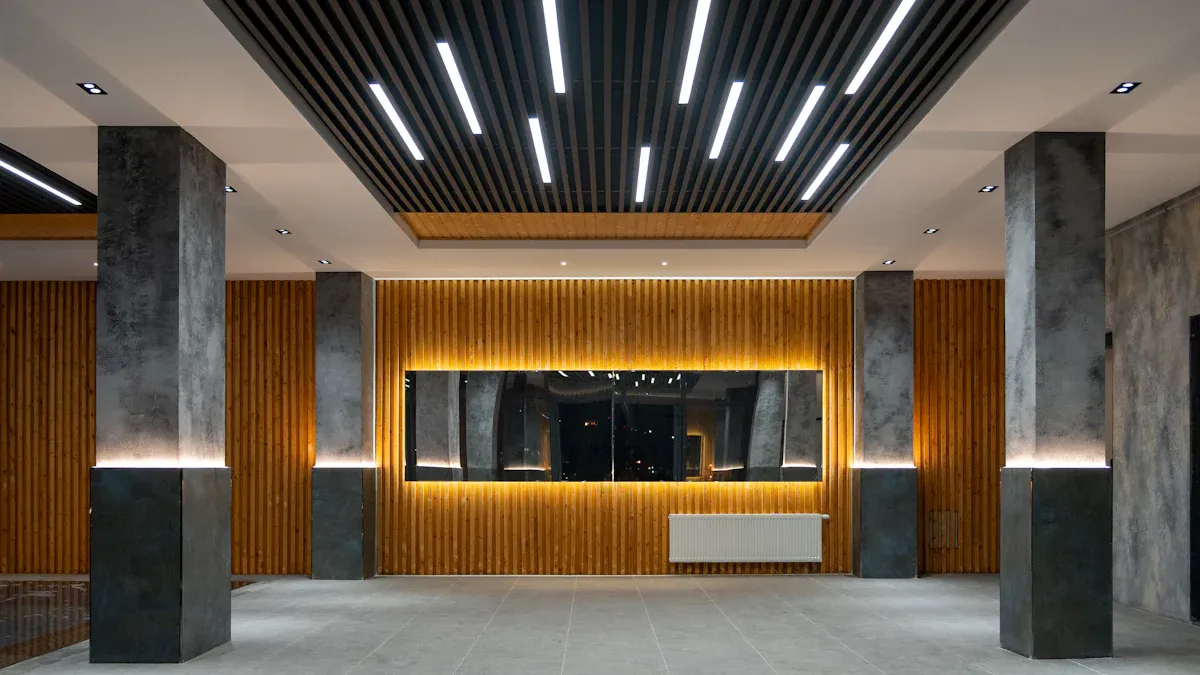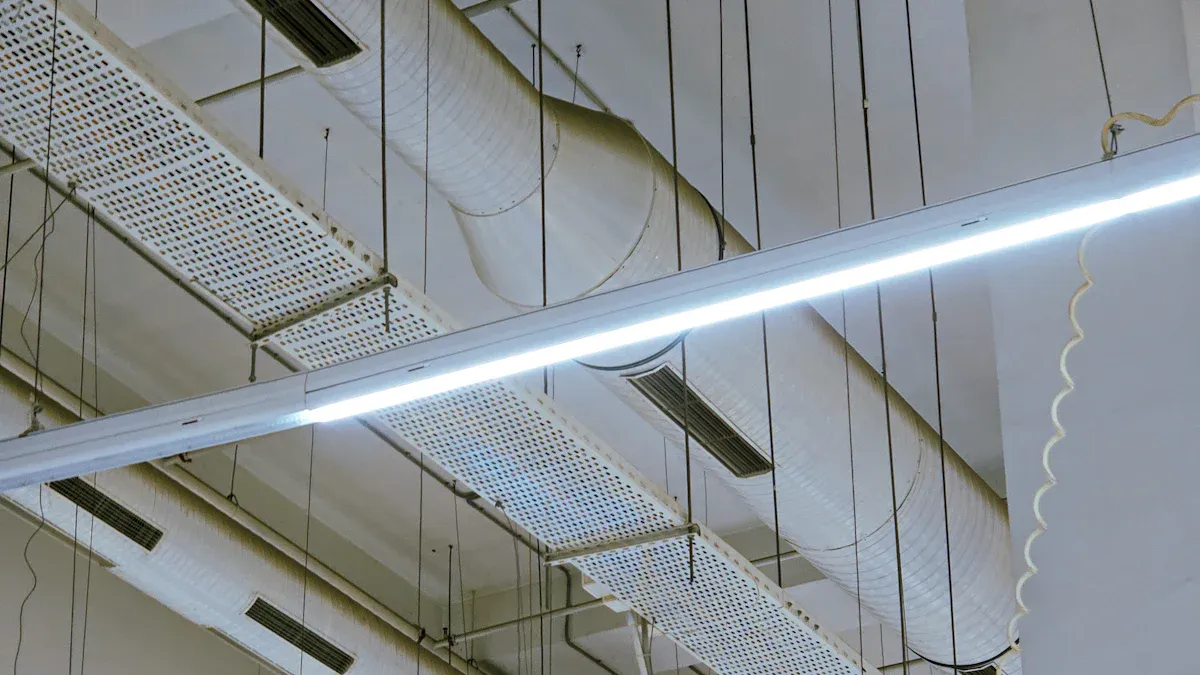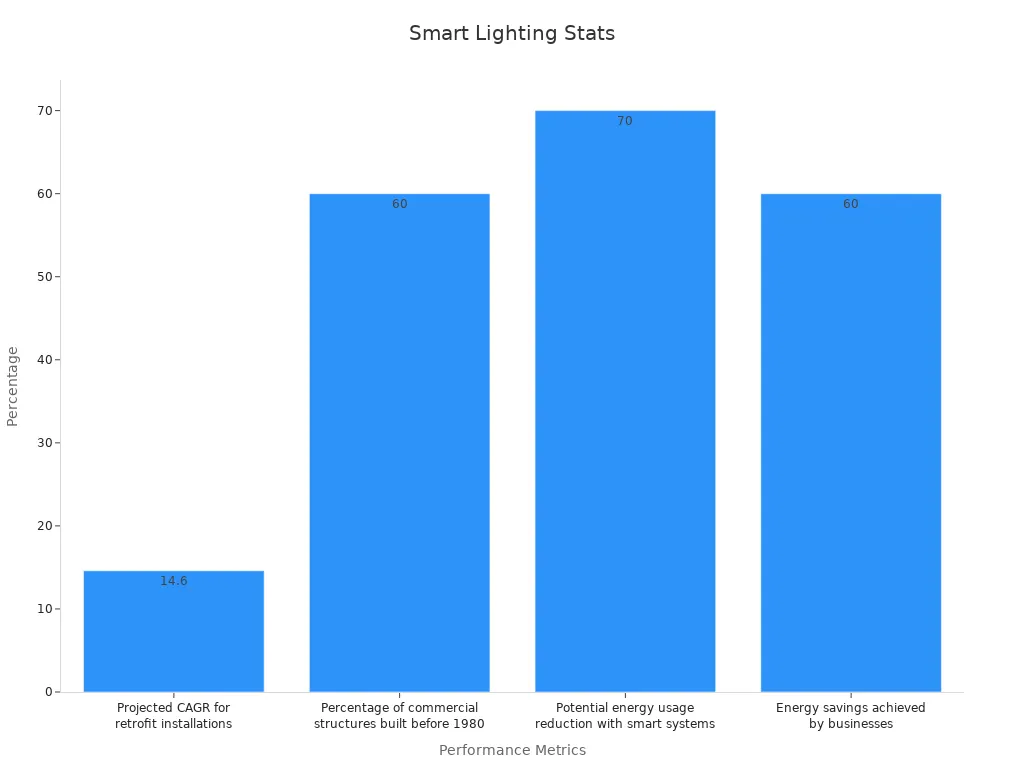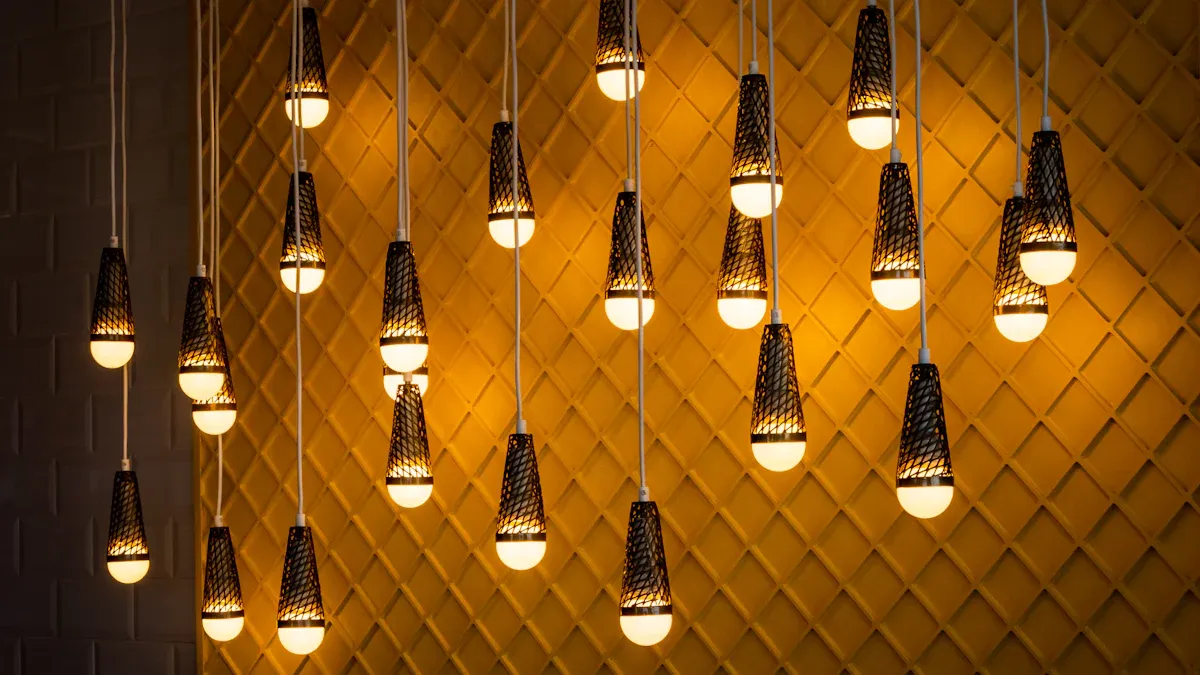Innovative Light Solutions for Commercial Properties: Balancing Aesthetics, Efficiency and Functionality

Lighting is very important for changing how spaces look. It affects how people feel and work in a place. Innovative Light Solutions, like LED lights, have transformed how businesses utilize lighting. These LED lights enhance the appearance of spaces while also saving energy.
LEDs use less energy, which is why many businesses prefer them.
The market for lighting and electrical services may grow to $1,117.67 billion by 2034. This indicates a rising demand for energy-saving systems.
Smart lights are becoming popular as businesses transition to better options.
Utilizing innovative light solutions can make spaces more inviting. It also helps save money and supports eco-friendly goals.
Key Takeaways
Using LED lights can lower energy bills by 60%. LEDs last longer and need less fixing, making them a good choice for businesses.
Smart lighting systems save energy by adjusting brightness. They change light levels based on activity, saving power and making spaces more comfortable.
Layered lighting uses different lights to make spaces useful and nice-looking. This method meets many needs and improves the experience.
Letting in more natural light helps people work better and feel good. Big windows and skylights can cut down the need for electric lights.
Matching lighting with your brand makes customers remember your business. Special lighting can show off products and create the right feeling for your space.
Key Considerations for Commercial Lighting Design
Knowing the building's design and purpose
Each commercial space is built for a specific use. To design good lighting, think about how it matches the building's look and purpose. For example, offices or stores need cooler white light to help people focus. On the other hand, warm light works better in places like restaurants or lounges to make them feel cozy.
Even lighting is very important. Uneven lights can cause dark spots, making spaces less useful and less attractive. Plan where to put lights carefully to avoid this. Adaptive lighting systems can also change brightness based on how much natural light is available or how busy the area is. This saves energy and improves safety.
Making energy efficiency a priority
Saving energy is key in modern lighting plans. Lighting uses 20-30% of energy in most buildings, and older ones can use up to 40%. Switching to LED lights and smart systems can cut energy costs by as much as 60%. LEDs last longer and use less power, making them a smart choice.
Smart systems save even more energy by adjusting brightness automatically. Sensors can dim or turn off lights when no one is around. These ideas lower costs and help protect the environment.
Statistic | Value |
|---|---|
Energy used by lighting in buildings | 20-30% |
Savings from upgrading to better lighting | Up to 60% |
Matching lighting to brand and mood
Lighting helps show off a brand's style and sets the mood. Custom LED lights come in many colors and brightness levels. This lets businesses pick lighting that fits their brand. Warm lights can make spaces feel calm, while bright lights create energy and excitement.
Good lighting design also improves customer experience and shows off the brand. For example, a fancy store might use spotlights to highlight special items, making them stand out. By matching lighting to your brand's goals, you can impress customers and tenants.
Tip: Work with architects and project managers to make sure the lighting fits the building's purpose and brand style.
Innovative Light Solutions for Commercial Properties

Advantages of LED technology in commercial lighting
LED lights have changed how businesses light their spaces. They are very efficient and last a long time. Unlike old bulbs, LEDs turn most energy into light, wasting very little. This helps businesses save money on electricity bills. LEDs can last over 50,000 hours, so they need fewer replacements and less maintenance.
LEDs also provide great lighting quality. They are bright, even, and don’t flicker, making spaces more comfortable. These lights are tough and can handle shocks, which is perfect for busy areas. You can also adjust their brightness to match your brand’s style and mood.
Advantage | Description |
|---|---|
Energy Efficiency | LEDs use less power and waste little energy. |
Long Lifespan | They last over 50,000 hours, saving money on replacements. |
Improved Lighting Quality | Bright, even, and flicker-free light improves visibility. |
Durability and Safety | Strong and shock-resistant, unlike fragile traditional bulbs. |
Flexibility and Control | Brightness can be adjusted to fit the space’s atmosphere. |
Smart lighting systems for automation and control
Smart lighting makes controlling lights easier and smarter. These systems use sensors to change brightness based on room activity or sunlight. This saves energy and makes spaces more convenient. For example, motion sensors can turn lights on or off when people enter or leave, cutting energy use by up to 60%.
Smart lighting does more than save energy. It helps workers by creating better-lit spaces that reduce eye strain. These systems also help the environment by lowering carbon emissions. Businesses can control lights remotely, keeping costs low and performance high.

Statistic | Value |
|---|---|
14.6% (2025-2033) | |
Percentage of commercial structures built before 1980 | 60% |
Potential energy usage reduction with smart systems | Up to 70% |
Energy savings achieved by businesses | Up to 60% |
Layered lighting approaches for enhanced functionality
Layered lighting uses different types of lights to improve spaces. It combines ambient, task, and accent lighting for better results. Ambient lighting lights up the whole area. Task lighting focuses on workspaces, and accent lighting highlights special features or products.
This method makes spaces more useful and attractive. It works well in offices and stores by meeting different needs. Layered lighting also helps divide areas and set the right mood. This creates a better experience for both workers and customers.
Tip: Use layered lighting to balance looks and usefulness. It saves energy and makes your property more appealing.
Integrating Natural Light and Sustainable Lighting Practices

Designing spaces to maximize natural light
Using natural light in buildings saves energy and helps people feel better. Workers with more sunlight have fewer headaches and sleep better. This improves their mood and makes them more productive. A survey found that 70% of workers said daylight helped them work better.
To increase natural light, architects use special tools to study sunlight patterns. These tools consider weather and location to design brighter spaces. Adding big windows, skylights, and shiny surfaces can bring in more sunlight. This reduces the need for electric lights during the day.
Tip: Work with designers early to match natural light with the building’s purpose.
Using energy-efficient materials and fixtures
Energy-saving materials and lights are important for eco-friendly lighting. LEDs use much less power than old bulbs and last longer. This lowers energy bills and cuts down on repairs. LEDs also give off better light, making them great for businesses.
Pairing LEDs with motion sensors or light controls saves even more energy. These systems adjust brightness based on sunlight or room activity. For example, a hotel in Miami Beach saved 75% on energy by switching to LED lights.
Incorporating renewable energy sources in lighting design
Using renewable energy in lighting reduces harm to the environment. Solar-powered lights are becoming more common in business spaces. A housing project in Tampa cut energy use by 50% with solar lights and smart systems.
LEDs, which use 75% less energy than old bulbs, work well with solar power. These systems save money and boost worker productivity by up to 6%. By using renewable energy, businesses can create greener spaces and meet sustainability goals.
Overcoming Practical Challenges in Commercial Lighting
Managing maintenance and operational costs effectively
Cutting costs in commercial lighting needs smart planning. Start by checking your current system for energy waste. Many businesses still use old lights, which cost more to run. Switching to LED lighting is a cheaper and smarter choice. LEDs use less energy and last longer, so you replace them less often.
Using tools to watch energy use in real-time can help. These tools show how much energy you use and where to save. You can also talk to energy companies for better deals on renewable energy. Checking costs and benefits regularly keeps your lighting system budget-friendly and efficient.
Method | Cost Impact |
|---|---|
Upgrade machinery | |
Use real-time energy tracking | See and control energy use |
Review cost-benefit often | Pick the best energy-saving options |
Negotiate energy contracts | Save with renewable energy deals |
Buy energy-saving equipment | Lower long-term costs |
Tip: Using LED lighting saves money and reduces maintenance work. This lets you focus on other important tasks.
Addressing glare and minimizing light pollution
Too much glare and light pollution can cause problems. Glare makes it hard to see and can be uncomfortable. Light pollution affects the environment around your property. To fix this, use lights that aim directly where needed. Shielded lights and dimmable LEDs are great for cutting glare.
The Outdoor Site-Lighting Performance (OSP) method helps reduce light pollution. It checks things like glare and sky glow to guide better designs. Studies using OSP on 125 projects showed how good planning stops light from escaping in places like parking lots or sports fields.
Note: Reducing glare makes spaces more comfortable and improves how your property looks.
Ensuring compliance with safety and building regulations
Following safety and building rules is very important for lighting projects. Make sure your lights meet local codes. This includes adding emergency lights and exit signs for safety during power outages. Using energy-saving lights can also help meet green building goals.
Regular checks and inspections keep your system safe and up to code. These checks find problems early, saving money later. Working with certified lighting experts ensures your system follows all rules and works well.
Tip: Stay updated on building rules to avoid fines and keep everyone safe.
The Role of Lighting in Branding and Customer Experience
Making tenants and customers happy with better lighting
Good lighting makes tenants and customers feel welcome. Using high-quality lights, like LED lighting, improves satisfaction. Happy tenants often stay longer and fill more spaces. LEDs give better color and even brightness, creating a cozy and pleasant place.
Switching to LED lighting also saves money. It lowers energy bills and reduces how often bulbs need replacing. These savings let businesses spend on other important things. Tenants like cost-saving and energy-efficient lighting, which adds to their positive experience.
Tip: Choose lighting that looks good and works well to make spaces inviting and keep tenants happy.
Turning commercial spaces into exciting places
Lighting can make spaces more fun and interesting. By combining different lights, like ambient, task, and accent lighting, you can create unique designs. Accent lights can highlight products or special features, making them stand out.
Smart lighting systems let you change brightness and colors for events or seasons. This helps match the mood to your brand and leaves a strong impression. Whether it’s a store or office, lighting that fits your style makes the space better for everyone.
Callout: Great lighting doesn’t just look nice—it keeps customers interested and satisfied.
Building your brand with creative lighting ideas
Creative lighting helps show off your brand’s style. Custom lights can match your brand’s look and feel. Keeping the same lighting design in all locations builds trust and makes your brand easy to recognize.
Smart lighting can also encourage people to shop. For example, bright lights can draw attention to products, making customers want to buy them. Modern lighting systems create spaces that fit your brand and make tenants and customers happy.
Note: Using creative lighting is a great way to connect with customers and make your brand stand out.
Making commercial spaces both useful and attractive is very important. Smart systems and LED lights have changed how businesses light their spaces. These solutions lower energy bills and make properties look better. The commercial lighting market is expected to grow to $49.82 billion by 2030. This growth is due to new technology and changing workplace needs.
To set up good lighting, follow these steps:
Check how much energy your current lights use.
Look at how each area is used daily.
Find out what kind of lighting each task needs.
Decide to upgrade old lights or add new ones.
Use smart tools like motion sensors to save energy.
Pick lighting that can grow with your business.
Use long-lasting lights like LEDs to save on repairs.
Follow safety rules and eco-friendly standards.
By using these ideas, you can create spaces that are efficient, stylish, and eco-friendly.
FAQ
What are the benefits of switching to LED lighting in commercial spaces?
LED lights save energy and last a long time. They lower electricity bills and need less maintenance. LEDs give bright, clear light that makes spaces more comfortable. Their eco-friendly design helps businesses meet green goals.
Tip: Switch to LEDs to cut energy costs by up to 60% and improve lighting.
How can smart lighting systems improve energy efficiency?
Smart lights use sensors to change brightness based on activity or sunlight. This stops wasting energy. You can control them remotely to use lights only when needed. These features save energy and reduce pollution.
Why is layered lighting important in commercial properties?
Layered lighting uses different types of lights for better results. It combines general, work, and decorative lighting to make spaces useful and attractive. This method boosts productivity and sets the right mood.
Note: Layered lighting makes customers happy and helps employees work better.
How does natural light benefit commercial spaces?
Natural light saves energy by reducing the need for electric lights. It helps people feel better and work harder. Workers in sunny spaces have fewer headaches and sleep better. Designing for daylight creates healthier workplaces.
What steps can you take to reduce glare and light pollution?
Use shielded lights and dimmable LEDs to aim light correctly. Avoid using too much light outside. The Outdoor Site-Lighting Performance method helps design spaces with less glare and sky glow. These steps make areas more comfortable and eco-friendly.
Callout: Cutting glare improves visibility and makes spaces more inviting.
See Also
Effective Commercial Lighting Strategies For Business Success
The Impact Of Modern Lighting On Business Spaces
Enhancing Road Safety With Efficient LED Highway Lighting

